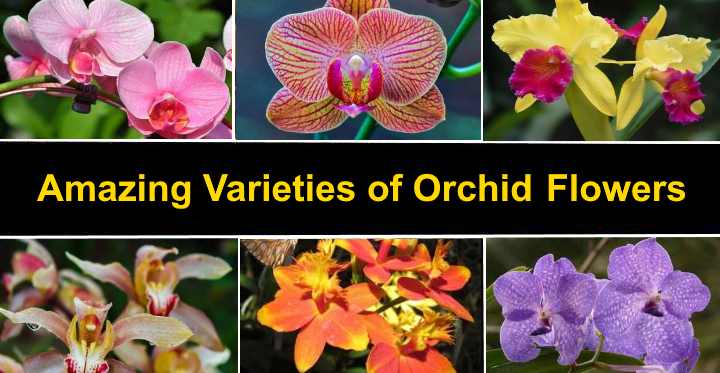Among the most exquisite and delicate blooms available, orchids may be found. Orchid flowers come in a wide range of shapes, colors, and sizes. Some of the tiniest mini orchid blooms are barely half an inch (1 cm) broad. The blossoms of large orchids can be up to 5 inches (12 cm) wide. Purple, white, red, orange, deep blue, pink, or yellow or any combination of those colors may be found in orchids and orchid hybrids.
Orchids belong to the Orchidaceae family of flowering plants, which are classed as either natural or cultivated. There are officially recognized over 28,000 species of orchids. There are even more hybrids, with a few estimates putting the number at over 100,000! The height and color of orchids vary greatly.
The Platystele orchid, which is just 2 mm in size, is the tiniest orchid available! Yet, from 6″ (15 cm) tall to roughly 30″ (76 cm) tall, orchids grown as houseplants vary. The type of orchid you purchase will determine the size and gorgeous colors of the orchid. Some of the most popular orchids for indoor growing will be discussed in this article. You’ll also learn about these orchids’ distinguishing characteristics and how to take care of them.
Types of Orchids (With Pictures and Names)
Phalaenopsis Orchids

About 70 species of orchids in the Phalaenopsis genus are widely popular and require little care. Because of the unusual form of their petals, phalaenopsis orchid is also known as moth orchid. The broad overlapping leaves at the base of the stem distinguish moth orchids from other orchids. The blades of these succulent leaves are leathery and typically occur in two rows. Phalaenopsis orchids are known for their huge attractive flowers. The flower is usually made up of 5 small to huge petals. Many flowers might bloom on each flowering stem, and they may bloom at various times of year.
Pure white orchid blooms, such as the Phalaenopsis aphrodite, are common. Orchids of this kind may have oranges, reds, and whites in their blossoms, which are striking. These may be delicate pastel purple, pink, and orange hues in particular. Yellow and red harlequin designs on the leaves are found in more unusual cultivars.
If you’re looking for an orchid that’s simple to establish, choose a phalaenopsis orchid. The phalaenopsis orchid is quite simple to cultivate and may be repotted countless times. Flowers may bloom numerous times and last for a long period of time.
Dendrobium Orchids

Dendrobium orchids are a widely cultivated type of orchid that requires little upkeep. The many blooms on the end of long stalks distinguish Dendrobium orchids. These orchids are top-heavy because of this, and they must be stalked to survive. The Dendrobium orchid genus has over 1,800 species. Purple, white, and yellow, or variations of those hues, are the most frequent hues found in Dendrobium orchids. The labellum (the orchid bloom’s “lip” section) is frequently a different color, which adds to the bloom’s wow factor.
The form of these orchids’ petals is a lovely characteristic. Several species have wide ruffled petals, which are pale in color and tend to be thin or tapered. Yet, it is tough to define an certain type of petal form for many orchid species. These orchid types are particularly popular since they may survive in practically any zone. Preventing these orchids from falling over is one of the challenges of their growth.
Clay pots and stalking are recommended by some orchid experts to help keep them upright. Only repot orchids from this genus when new growth appears. To thrive, they also need a lot of light.
Epidendrum Orchids
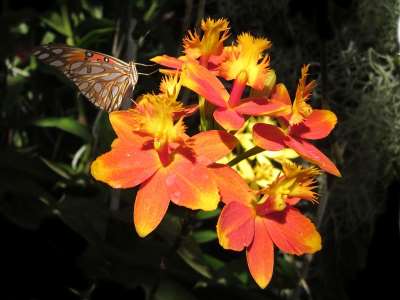
If grown indoors as houseplants, Epidendrum orchids need a lot of sunlight. The Epidendrum genus contains over 1,000 species, with many more hybrids. Rather than being broad and oval, the delicate attractive blooms are thin and stretched. This orchid’s flowers are tiny and delicate in general. Although they aren’t as large or noticeable as other well-known orchid types, epidendrum orchids are quite fragrant. Pink, dark orange, and white flowers are most common.
Your Epidendrum orchid should bloom yearly with proper care and lighting. Growing these orchids indoors may be challenging due to their high light requirements. As a result, if they don’t receive enough light, they may only bloom once.
Cattleya Orchids
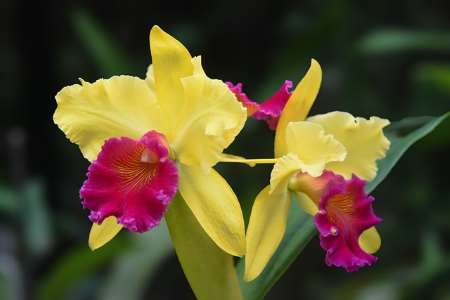
Cattleya orchids have stunning flowers that are different in color. The petals and labellum of these flowers are distinguished by their contrasting hues. Specks, freckles, or streaks patterning the petals are another interesting feature of these orchids. The fact that many of these orchids have a fragrant smell is one of their identifying characteristics. Large ruffled white petals contrasting with a deep orange center look stunning in some hybrids. These orchids are particularly lovely since to their slender, long, extended petals.
Cattleya leaves may be oblong or elliptical in shape and are typically thick and succulent. Orange, white, pink, mauve, and deep purple are some of the most popular orchid colors. Look for orchid types that feature a striking combination of colors in the centres. Indoors, they are quite simple to grow and you may repot them after they have stopped flowering.
Cymbidium Orchids
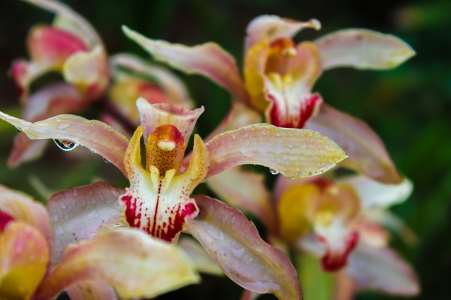
Cymbidium is a genus of orchids with tiny petals and blossoms that have grassy leaves and tall stems. The numerous blossoms, on the other hand, create a stunning floral show. These magnificent orchids thrive in warm regions and bloom often if you live there. Cymbidium orchids are a very simple houseplant to maintain as an indoor plant.
Bright pink, green, yellow, or red Cymbidium orchids are some of the most stunning. The long grassy green leaves that are generally longer than the flower stalks are an identifying characteristic of these orchids. This sort of orchid variety is ideal for rookies because it is simple to grow and maintain. Care instructions: orchid plants of this type are ideal for novices.
Lycaste Orchids

Lycaste is a genus of orchids that includes about 30 species, all of which grow from pseudobulbs. The orchid’s triangular bloom is quite huge and waxy. As a result, rather than being stored underground (like bulbs), the storage organ is above-ground. This kind of orchid has three huge wide petals that face out in the three corners of a triangle. The single-colored waxy petals are typically devoid of patterns.
The fragrance of these blooms is moderate. These orchids have spicy scents, such as clove and cinnamon, according to some aromas. Lycaste orchids have medium to large-sized flowers, which is a lovely feature. Flowers in most varieties range in size from 2 to 4 inches (5 to 10 cm). Hybrids, on the other hand, may produce flowers that are 7 inches (18 cm) broad.
These orchids lose their leaves and halt development during the winter because they are a deciduous type. If you touch the ends of the pseudobulb, your finger may get jagged. You should repot this kind of orchid after it finishes blooming because it prefers moderate light.
Brassavola Orchids

Brassavola orchids are a leafy type of orchid with white flowers that release scent only at night. The heady fragrance this common orchid emits at night gives it its name. White petals and a very fragrant nature distinguish most Brassavola orchid species. Certain combinations may have a faint speckled pattern. These orchids bloom frequently and may bloom all year if the conditions are right.
The long reed-like leaves are another distinguishing feature of this orchid variety. These give the orchid the appearance of a bushy green clump with beautiful white flowers blossoming from it. During the growing season, water them frequently and provide them with medium light but no direct sunlight.
Maxillaria Orchids

Maxillaria tenuifolia is a genus of orchids containing approximately 300 species. They are very diverse orchids, despite the fact that there are not as many species as other groups. The lip in the center of this orchid looks like a jawbone (maxilla in Latin), so the Latin name for this species is jawbone orchid. 3-petaled types in a fiery-red color with yellow tips are known as flame orchids, spider orchids, and tiger orchids.
Some types produce extremely huge showy flowers, even if the blossoms are produced on short stalks. Some bright types are coveted by collectors, despite the fact that they are not one of the most popular orchids to cultivate at home. They are a prized orchid because of their robust fragrance and lovely blossoms.
Miltonia Orchids

Miltonia regnellii, a purple and green orchid, has lovely and elegant flowers. Because the oval blossoms resemble pansies, this is also known as the pansy orchid. Hybrid and cultivars differ substantially from one another, as they do in many orchid families. Beautiful huge pastel-colored blooms with contrasting darker colors can be found on some exotic orchids. This gives these orchids a sparkle and refinement that adds elegance to a space.
Tipped leaves of Miltonia orchids come in green and brown hues, and they are tapered. A white petal or flower lip adds to the beauty of these blooms. The orchid’s ornamental showy look is created by papery ruffled petals in other Miltonia hybrids. It’s best to keep them evenly moist all year. To help them bloom, they need bright indirect light.
Odontoglossum Orchids

Odontoglossum orchids have some spectacular flowering hybrids, with their showy and unusual blossoms making them a great decorative plant. This kind of orchid has up to 150 blooms and stems that can grow up to 4 feet (1.2 meters) tall. This genus contains nearly 400 species, and even more hybrids are available.
Some orchids have oval, ruffled petals, while others have enormous triangular petals that give the orchid a star-like appearance. Pure white petals with crimson splotches and a yellow center characterize the Odontoglossum crispum hybrid. Colors are also present in a wide variety of species. From dark reds, purples, and brown to brilliant yellows, whites, and pink are available. This kind of orchid is difficult to grow indoors, according to experts.
Paphiopedilum Orchids

The Paphiopedilum orchid has a wide range of hybrids and is simple to maintain at home. The Venus slipper or Lady slipper is the name for this lovely plant, which comes in a variety of cheerful hues. There are several color options to choose from, such as deep pinks, brilliant whites, and sun-kissed yellows. Paphiopedilums in burgundy, deep pink, and black are available if you prefer darker colors.
One large oval petal and two elongated petals are among the distinguishing characteristics of paphs. The lone oval petal and other petals in several of the hybrids are radically distinct colors. Another way to identifying these orchids is by their large cup-like lip. Before the stems develop and bloom, growth begins with huge thick leaves. Plant care: Keep the potting soil moist by watering it on a regular basis. It’s really simple to cultivate this orchid variety at home.
Vanda Orchids

Vanda orchids come in a wide range of hues, and their root system is particularly robust. Vanda orchids are best grown in orchid baskets due to their large and lengthy roots. With their lovely blossoms, long light-green leaves, and delicate green roots dangling from the basket, these exotic orchids are stunning.
Experts consider these orchid varieties to be some of the most gorgeous orchids in the world when it comes to their blossoms. Pale lavender, deep violet, white, and pink are some of the colors available. Some are long and tapered, with dots or stripes, while others are broad and oval with speckled patterns.
Vanda orchids may produce flowers several times throughout the year if cared for correctly. This kind of orchid is difficult to cultivate at home and requires expertise for novice orchid growers. For healthy development, the balance of humidity and moisture is crucial.
Zygopetalum Orchids
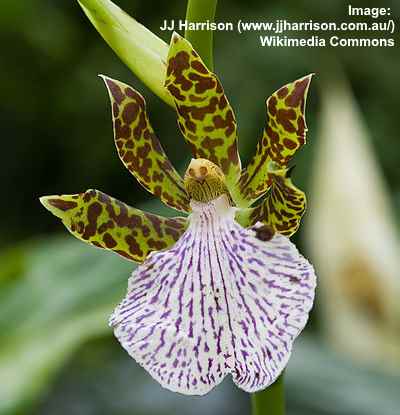
Zygopetalum orchids have a variety of patterns and colors and may be found growing in humid, warm climates. On each stem, there are a lot of highly patterned blooms. These orchids have a striking appearance due to the combination of long tapered petals and a huge oval one.
The multi-colored flowers are a distinguishing characteristic of these orchids. One flower can include purple and nearly black petals. This is not uncommon. In addition, certain plants feature green/brown leaves with a solitary huge white/purple leaf.
Long-lasting fragrant flowers are another characteristic of these orchids. These orchid flowers make excellent cut flower arrangements due to their waxy nature. When it comes to humidity, water, and light, they have very specific requirements.
Oncidium Orchids
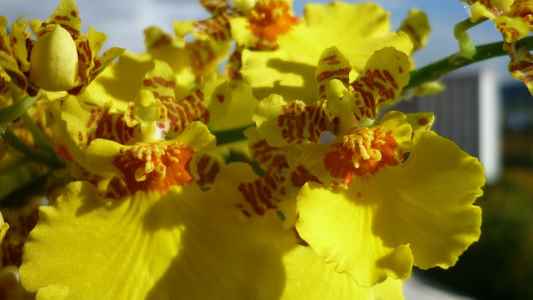
Oncidium orchids are called “Dancing-Lady orchids” or “Golden Shower orchids,” and their flowers have a beautiful form and bright colors. Bright yellow, pink, red, and white are some of the most common Oncidium orchid colors. Several varieties of these orchids may reach heights of 16 feet (5 meters)! Despite their exotic appearance, these orchids are simple to cultivate at home. They must be in free-draining orchid mix and away from drafts because of their large pseudobulbs.
Psychopsis Orchids

The Psychopsis orchids are home to a variety of orchids with enormous antennae-like petals. These exquisite orchid types feature minuscule blooms hanging off tall spikes and are sometimes known as the ‘Butterfly orchid.’ The orchid resembles a butterfly with its frilly petals, which have enormous antennae-like petals. Easy to grow, and thrives in modest lighting conditions.
Phragmipedium Orchids

The Phragmipedium orchid, sometimes known as a “Lady’s Slipper orchid,” has a white sac-like lip that resembles a pouch. These orchids have the ability to tolerate a lot of water, which is one of their characteristics. The oval-shaped petals and narrow leaves of these orchids are another distinguishing feature, in addition to their lady slipper pouch. Phragmipedium orchids are the only ones with a brilliant red color among the species of orchids that have a pouch lip.
